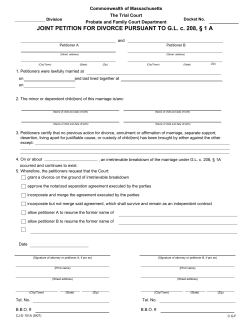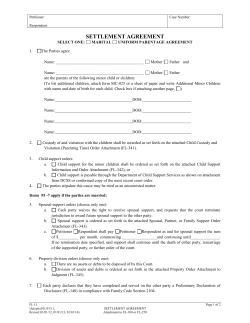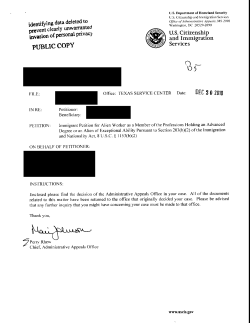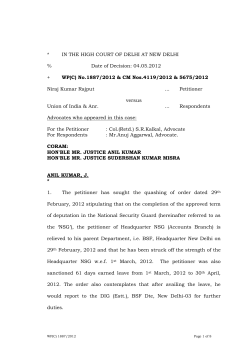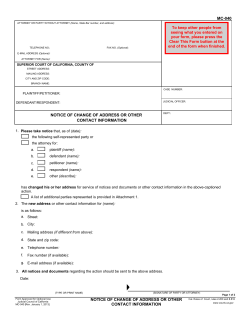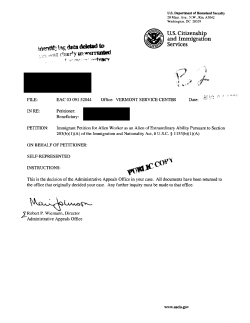
UNITED STATES DISTRICT COURT FOR THE EASTERN DISTRICT OF MICHIGAN SOUTHERN DIVISION _____________________________________________________________________
2:07-cv-13566-RHC-PJK Doc # 16 Filed 09/29/09 Pg 1 of 16 Pg ID 2919 UNITED STATES DISTRICT COURT FOR THE EASTERN DISTRICT OF MICHIGAN SOUTHERN DIVISION _____________________________________________________________________ MICHAEL ELLIOT, #236879, Petitioner, v. Case No. 07-CV-13566 MARY BERGHUIS, Respondent. _________________________/ OPINION AND ORDER DISMISSING THE PETITION FOR WRIT OF HABEAS CORPUS, DENYING PETITIONER’S MOTION TO EXPAND THE RECORD, AND DECLINING TO ISSUE A CERTIFICATE OF APPEALABILITY Pending before the court is Petitioner Michael Elliot’s second petition for writ of habeas corpus, filed August 24, 2007, pursuant to 28 U.S.C. § 2254. The Sixth Circuit granted Petitioner leave to file a second or successive petition. In re Elliot, Case No. 07-1067 (6th Cir. June 19, 2007). On March 14, 1994, Petitioner was convicted in Gladwin County Circuit Court of four counts of premeditated murder, Mich. Comp. Laws § 750.316; one count of armed robbery, Mich. Comp. Laws § 750.529; one count of entry without breaking with intent to commit a larceny, Mich. Comp. Laws § 750.111; arson of a dwelling house, Mich. Comp. Laws § 750.72; and one count of possession of a firearm during the commission of a felony, Mich. Comp. Laws § 750.227b. Petitioner is a state prisoner incarcerated at the Ionia Maximum Correctional Facility in Ionia, Michigan. On December 11, 2008, Petitioner filed a motion to expand the record. For the reasons stated below, the court will deny Petitioner’s motion, dismiss the habeas petition, and decline to issue a certificate of appealability. 2:07-cv-13566-RHC-PJK Doc # 16 Filed 09/29/09 Pg 2 of 16 Pg ID 2920 I. BACKGROUND As the court found in its 2000 Opinion and Order Denying Petition for Writ of Habeas Corpus, the facts of this case are as follows: Petitioner’s conviction arises out of an incident that occurred in Bentley Township, Michigan in the early morning hours of August 8, 1993. Petitioner was charged with committing these crimes with Charles Treece, Paul Treece, and Tammy LaCross. Following a jury trial in the Gladwin County Circuit Court, petitioner was convicted of the above offenses. Tammy LaCross testified against petitioner as part of a plea agreement. In exchange for her testimony, the prosecutor allowed LaCross to plead guilty to the armed robbery and felony-firearm counts and agreed to dismiss the remaining first degree murder, arson, and breaking and entering counts against her. LaCross was the daughter of one of the victims in this case, Vickie Currie. Currie lived with another of the victims, Michael Tufnell. LaCross believed that Tufnell had a large amount of money that he had earned through selling narcotics located in a storage facility. On August 7, 1993, LaCross and the Treece brothers agreed to break into the unit and steal the money. LaCross and the Treeces left the house that they shared in Grand Rapids and drove to petitioner’s aunt’s house in Saginaw to meet petitioner. When they arrived in Saginaw, petitioner was not home, so the three co-defendants waited for him to return. When petitioner came home, he showed Chuck Treece a .38 caliber pistol with the serial numbers welded off. LaCross later identified this pistol as the gun that the police seized from petitioner at the time of his arrest. Petitioner and the three co-defendants left Saginaw and drove to the storage facility where Tufnell had a storage unit. Petitioner and Chuck Treece wore gloves so that they would not leave any fingerprints. Although petitioner and Chuck Treece broke into the unit identified by LaCross as belonging to Tufnell, they were unable to locate any money in this unit. Petitioner and Chuck Treece then broke into several other units at the storage unit and stole a .28 gauge shotgun, a bag of ammunition, and some liquor from one of the units. Police recovered a flashlight from outside the storage facility and discovered that a battery found inside the flashlight had petitioner’s fingerprints on it. After leaving the storage area, Chuck Treece asked LaCross if her aunt still had a safe at her house. When LaCross replied affirmatively, the four co-defendants agreed that they would drive to the house to steal 2 2:07-cv-13566-RHC-PJK Doc # 16 Filed 09/29/09 Pg 3 of 16 Pg ID 2921 money from there. On the way to LaCross’s aunt’s house, the four decided to check to see whether the shotgun worked in case they needed to use it to commit a robbery if someone was at the house. They stopped at an oil well and test fired the weapon. While testing the weapon, petitioner and Chuck Treece were drinking tequila and beer. After leaving the oil well, the four accomplices drove by LaCross’s aunt’s house, but did not stop when they saw the lights on. The four co-defendants then decided to break into the house shared by Currie and Tufnell. A plan was then made for Chuck Treece and petitioner to commit an armed robbery upon Tufnell if they discovered him at home. LaCross told Chuck Treece about an unlocked window that could be used to gain access into the house. The four drove over to Tufnell’s house, which was located near the aunt’s house. Petitioner and Chuck Treece exited the car wearing gloves and carrying guns. Petitioner was carrying his .38 pistol and Treece had the shotgun which had been stolen from the storage unit. LaCross and Paul Treece remained in the car and eventually fell asleep. Some time thereafter, LaCross awoke to the sound of gunshots. Petitioner and Chuck Treece then drove by in a Cadillac belonging to one of the other murder victims, Cathy Lane, and told LaCross to follow them. Prior to leaving the crime scene, the house was set on fire. The four co-defendants ended up at petitioner’s aunt’s house in Saginaw. Once inside of the house, petitioner told the others that he had shot Tufnell in the head and had shot everyone in the back of the head. Petitioner was laughing as he made these remarks. Over defense counsel’s objection, LaCross testified that Chuck Treece told the others that he had shot Currie’s arm off and also told the others how petitioner had shot Tufnell and Lane in the face. Petitioner was present when Treece made these remarks and laughed in response to them. LaCross also noted that Chuck Treece had Tufnell’s .357 magnum with him. Co-defendant Paul Treece also testified against petitioner in exchange for a plea bargain. Paul Treece had been permitted to plead guilty to one count of armed robbery and one count of felony-firearm in exchange for his testimony. Paul Treece’s testimony basically corroborated LaCross’s account of the events surrounding the crime. Paul Treece specifically recounted that petitioner and his brother Chuck had talked about going to Tufnell’s house and robbing him prior to the murders. 3 2:07-cv-13566-RHC-PJK Doc # 16 Filed 09/29/09 Pg 4 of 16 Pg ID 2922 Enrique Delacruz testified for the prosecution in exchange for immunity. Delacruz testified that after the murders, petitioner and Chuck Treece sold him Tufnell’s .357 magnum. Delacruz ultimately gave this gun to the police. Edward Hendrix, another friend of petitioner’s, testified that he saw petitioner in Grand Rapids on August 10, 1993 and told petitioner that the police were looking for him. In response, petitioner stated: “we smoked them who’es.” Hendrix indicated that this was street lingo for killing someone. Petitioner also showed him a handgun, which Hendrix identified as being the same one that was seized from petitioner by the police at the time of his arrest. Police recovered Cathy Lane’s Cadillac in a field in Saginaw about a mile from where petitioner lived. Police also searched petitioner’s aunt’s house and recovered the bag of ammunition taken from the storage shed and some pistol grips that would fit the revolver recovered from petitioner. Petitioner was arrested in Saginaw, Michigan on August 12, 1993. When police went to arrest him, petitioner took off running and led them on a foot chase. After petitioner was thrown to the ground and restrained, the police recovered a .38 caliber pistol from petitioner’s pocket which other witnesses identified as being the gun in petitioner’s possession the night of the murder. It was later determined through ballistics that ten of the fifteen bullets used to kill the four victims came from this weapon. Upon arrest, petitioner told the police his name was “James Delarosa”. Petitioner presented an alibi defense through his testimony and the testimony of his sister and his sister’s friend. Petitioner contended that he was at his aunt’s house in Saginaw on the night of the murder. Petitioner also claimed that LaCross had sold the .38 caliber gun to him the day after the murders, and further opined that someone must have stolen his flashlight, which had been recovered by the storage shed. Petitioner further claimed that the various witnesses were lying to save themselves. Elliot v. Caruso, No. 99-70430, slip op. at 1-6 (E.D. Mich. Feb. 25, 2000). On March 14, 1994, a jury convicted Elliot. The Michigan Court of Appeals affirmed his conviction, People v. Elliot, No. 174954 (Mich. Ct. App. Mar. 18, 1997), and the Michigan Supreme Court denied review, People v. Elliot, No. 109085 (Mich. Jan. 30, 1998). In 1998, Petitioner filed a petition for a writ of habeas corpus, which this court denied. In 2005, 4 2:07-cv-13566-RHC-PJK Doc # 16 Filed 09/29/09 Pg 5 of 16 Pg ID 2923 Petitioner filed a motion for relief from judgment based on an allegation of newly discovered exculpatory evidence, namely an affidavit by Charles Treece in which he attested to Petitioner’s innocence. The state court denied the motion. The Michigan Court of Appeals and the Michigan Supreme Court both denied leave to appeal. Pursuant to 28 U.S.C. § 2244(b), the Court of Appeals for the Sixth Circuit granted Petitioner leave to file a second or successive petition for a writ of habeas corpus. In re Elliot, No. 07-1067 (6th Cir. June 21, 2007). Petitioner seeks a writ of habeas corpus because: I. The trial court erred in denying a new trial where newly discovered evidence exculpates the defendant. II. Defendant was denied due process of law by the prosecutor’s suppression of material evidence in violation of Brady. III. Due process requires an evidentiary hearing where newly discovered evidence includes an uncontested allegation of suppression of material evidence by the prosecutor. (Petr.’s Mot. at 9.) Petitioner alleges that the prosecutor hid a 1994 letter from coconspirator Charles Treece (“1994 Letter”). In the letter, Charles proclaimed Petitioner’s innocence. Petitioner states that he did not know about the existence of this letter until after Charles’s January 25, 2005, affidavit (“2005 Affidavit”). In the 2005 Affidavit and a second affidavit dated May 12, 2008 (“2008 Affidavit”), Charles maintains that Petitioner did not commit any of the murders and recites Petitioner’s current claim of innocence: that Charles and the others snuck away to commit the crimes at night while Petitioner slept; used things stolen from Petitioner; and then they hid the things in Petitioner’s aunt’s basement the next morning. The 2005 and 2008 Affidavits also allege that Charles told the prosecutor of Petitioner’s “innocence” in 1993 or 1994. 5 2:07-cv-13566-RHC-PJK Doc # 16 Filed 09/29/09 Pg 6 of 16 Pg ID 2924 Respondent argues that Petitioner has not demonstrated a Brady claim that can support his habeas petition, and that, in any event, Petitioner has defaulted his claim. II. STANDARD1 The provisions of the Antiterrorism and Effective Death Penalty Act of 1996 (“AEDPA”) Pub. L. No. 104-132, 110 Stat. 1214 (Apr. 24, 1996), which govern this case, “circumscribe[d]” the standard of review federal courts must apply when considering applications for a writ of habeas corpus raising constitutional claims, including claims of ineffective assistance of counsel. See Wiggins v. Smith, 539 U.S. 510, 520 (2003). Before proceeding to evaluate a second or successive § 2254 petition, a court must first consider whether a petitioner has complied with special requirements as provided for in 28 U.S.C. § 2244. This section requires that: A claim presented in a second or successive habeas corpus application under section 2254 that was presented in a prior application shall be dismissed unless– (A) the applicant shows that the claim relies on a new rule of constitutional law, made retroactive to cases on collateral review by the Supreme Court, that was previously unavailable; or (B)(i) the factual predicate for the claim could not have been discovered previously through the exercise of due diligence; and (ii) the facts underlying the claim, if proven and viewed in light of the evidence as a whole, would be sufficient to establish by clear and convincing evidence that, but for constitutional error, no reasonable factfinder would have found the applicant guilty of the underlying offense. 1 Petitioner preliminarily argues that his application does not constitute a second or successive petition because he presents new claims of suppression of evidence of actual innocence. However, Petitioner himself moved for leave to file a second or successive petition from the Sixth Circuit on the basis of newly discovered evidence, and the Sixth Circuit agreed that Petitioner made “a prima facie showing that the application satisfies the requirements” of § 2244. See 28 U.S.C. § 2244(b)(3)(c). Accordingly, the court will examine Petitioner’s claims under the standard for second or successive habeas petitions. 6 2:07-cv-13566-RHC-PJK Doc # 16 Filed 09/29/09 Pg 7 of 16 Pg ID 2925 28 U.S.C. § 2244(b)(2). Furthermore, a “district court shall dismiss any claim presented in a second or successive application that the court of appeals has authorized to be filed unless the applicant shows that the claim satisfies the requirements of this section.” 28 U.S.C. § 2244(b)(4). The provisions of the Antiterrorism and Effective Death Penalty Act of 1996, codified at 28 U.S.C. § 2241 et seq., govern this case because Petitioner filed his habeas petition after AEDPA’s effective date. See Lindh v. Murphy, 521 U.S. 320, 336 (1997). III. DISCUSSION Petitioner argues that his Petition meets § 2244’s requirements because he has offered new factual evidence of innocence. To succeed, Petitioner must: (1) show a factual predicate which Petitioner could not have previously discovered through due diligence; and (2) show by clear and convincing evidence that but for constitutional error; (3) no reasonable factfinder would have found petitioner guilty of the underlying offense.2 28 U.S.C. § 2244(b)(2)(B). The new evidence on which Petitioner mainly relies to satisfy § 2244 are the 2008 and 2005 Affidavits, and the 1994 Letter.3 2 The Sixth Circuit has used the term “actual innocence” when referring to the requirements of § 2244(b)(2)(B)(ii). See Keith v. Bobby, 551 F.3d 555, 557 (6th Cir. 2009). 3 Petitioner has also filed a motion to expand the record pursuant to Rule7(b) of the Rules Governing Section 2254 Cases. He requested supplementing the record with an affidavit by Talena O’Dell, which Petitioner alleges he received on December 5, 2008. In the affidavit, O’Dell states while incarcerated with Tammy LaCross at Florence Crane in Coldwater, Michigan, Lacross told O’Dell that Petitioner “had no involvement in this crime at all,” and that LaCross further stated that LaCross and Charles “were the only ones that entered the house during this crime.” (O’Dell Aff. ¶¶ 8-9.) First, Rule 7 does not provide Petitioner a way to expand the record at this point in the proceedings; 7 2:07-cv-13566-RHC-PJK Doc # 16 Filed 09/29/09 Pg 8 of 16 Pg ID 2926 Petitioner maintains that the court should not dismiss his habeas petition because the prosecutor failed to disclose the 1994 letter as required by Brady v. Maryland, 373 U.S. 83 (1963), and that the 1994 Letter and its evidentiary fruits would have been a factual predicate that satisfies § 2244(b)(2)(B)(ii)’s strictures.4 As a preliminary matter, Respondent contends that Petitioner procedurally defaulted on his Brady claim because he did not raise it until his state court postconviction motion for relief from judgment. (Resp. Ans. at 16.) The Michigan Supreme Court denied Petitioner’s appeal under Michigan Court Rule 6.508(D) because Petitioner did not establish “entitlement to the relief requested.” MCR 6.508(D); People v. Elliot, No. 132159 (Mich. Dec. 28, 2006). The last reasoned opinion from a state court, however, denied Petitioner’s motion for post-conviction relief on the merits under Michigan Court Rule 6.504(B). MCR 6.504(B); People v. Elliot, No. 93-5282-FC (Mich. Cir. Ct. Mar. 17, 2005). Petitioner did not, however, raise his Brady claim in his state court post-conviction motion, relying instead upon a claim of “discovery of new evidence of his actual innocence,” viz. Charles’s 2005 Affidavit. People v. Elliot, No. 93-5282-FC rather, the judge in a case may direct further evidence if the habeas petition is not dismissed. R. Governing Sec. 2254 Cases 7(a) (“If the petition is not dismissed, the judge may direct the parties to expand the record by submitting additional materials relating to the petition.”). Because the court will dismiss the petition, the court will also deny Petitioner’s motion. Moreover, the affidavit would not change the outcome of this petition. Petitioner cannot allege a constitutional error in connection with the affidavit so as to satisfy the standard for a second or successive petition. Finally, the court notes that such post-trial, conclusory exculpatory affidavits are viewed with great skepticism. Herrera v. Collins, 506 U.S. 390, 423 (1993). 4 To the extent that Petitioner states distinct claims of actual innocence and a Brady violation (Petr.’s Mot. at 9), only the latter could satisfy § 2244 because it states a “constitutional error.” In addition, § 2244 implicitly includes Petitioner’s claim of actual innocence. See Lott v. Bagley, No. 1:04 CV 822, 2007 WL 2891272, *14-15 (N.D. Ohio Sept. 28, 2007), affirmed Lott v. Bagley, 569 F.3d 547 (6th Cir. 2008). 8 2:07-cv-13566-RHC-PJK Doc # 16 Filed 09/29/09 Pg 9 of 16 Pg ID 2927 (Mich. Cir. Ct. Mar. 17, 2005). But Petitioner only wrote to Charles to determine if Charles possessed any further proof of Petitioner’s innocence, after the circuit court denied his motion for post conviction relief. (Petr.’s Reply at 3-4.) At that time, Charles produced the 1994 Letter. (Petr.’s Reply at 3-4.) Regardless, the Sixth Circuit has stated that when the “last reasoned state-court opinion issued . . . denied relief on the merits,” then “the Michigan Supreme Court’s general reference to Mich. Ct. R. 6.508(D) should be interpreted as relying on the merits-based portion of the rule,” and thus does not constitute “an adequate and independent state procedural sanction sufficient to preclude habeas review.” Ivory v. Jackson, 509 F.3d 284, 292 (6th Cir. 2007). Accordingly, Petitioner’s claims are not procedurally defaulted to the extent that they are based on arguments presented to and ruled on by the state court. See id. The analysis for showing cause and prejudice justifying excusing procedural default is the same as the analysis for determining the suppression and prejudice elements of a Brady claim. Banks v. Dretke, 540 U.S. 668, 691 (2004). Since the court addresses the Brady analysis below, it will not address the procedural-default excuse analysis here. See id. A. Constitutional Violation Petitioner argues that § 2244(b)(2)(B)(ii)’s requirement of a constitutional error is met because the prosecutor failed to disclose Brady material. The Supreme Court has stated that “[t]here are three components of a true Brady violation: [1] The evidence at issue must be favorable to the accused, either because it is exculpatory, or because it is impeaching; [2] that evidence must have been suppressed by the State, either willfully or inadvertently; and [3] prejudice must have ensued.” Strickler v. Greene, 527 U.S. 9 2:07-cv-13566-RHC-PJK Doc # 16 Filed 09/29/09 Pg 10 of 16 Pg ID 2928 263, 281-82 (1999). Further, “the third element of a Brady claim, is established only if the suppressed evidence is material; evidence is material under Brady only if it presents a ‘reasonable probability’ that the outcome of the trial would have been different if the evidence had been disclosed.” Pudelski v. Wilson, 576 F.3d 595, 614 (6th Cir. 2009); see also United States v. Bagley, 473 U.S. 667, 682 (1985) (“reasonable probability” is “a probability sufficient to undermine confidence in the outcome”). Accordingly, Brady does not require disclosure of all information which may be helpful to the defense. Johnson v. Bell, 525 F.3d 466, 475 n.3 (6th Cir. 2008) (quoting Kyles v. Whitley, 514 U.S. 419, 436-37 (1995) (“We have never held that the Constitution demands an open file policy.”)). Finally, Petitioner has the burden of establishing each of Brady’s elements. Carter v. Bell, 218 F.3d 581, 601 (6th Cir. 2000) (citing Moore v. Illinois, 408 U.S. 786, 794-95 (1972)). Petitioner offers three new pieces of evidence: the 2005 and 2008 Affidavits, and the 1994 Letter. Only the 1994 Letter could be Brady material, because the affidavits were written after the trial concluded. The 1994 Letter states in relevant part: [M]y brother Paul and [Petitioner] are innocent and I will only plea[d] guilty if you let them both go. And you told my attorney that you will only let Paul off. I am telling you that my brother and [Petitioner] are innocent they [sic] did nothing and that’s the only way I will plea[d] guilty to murder for you. (Pet’r.’s Mot. App. H.) First, the letter is not entirely exculpatory. At trial Petitioner testified—as an alibi—that he “hung out all day, and all night” with Charles. The claim that Charles committed the murders in the 1994 Letter and the affidavits therefore directly contradicts Petitioner’s testimony, thus suggesting that Petitioner perjured himself. 10 2:07-cv-13566-RHC-PJK Doc # 16 Filed 09/29/09 Pg 11 of 16 Pg ID 2929 Second, the court is not convinced that the Petitioner has met his burden of showing that the 1994 Letter was “suppressed by the State, either willfully or inadvertently.” See Strickler, 527 U.S. at 281-82. Petitioner argues that state suppression is proven by the 1994 letter, the 2008 Affidavit, correspondence between Charles and his attorney, and correspondence between Charles’s attorney and the prosecutor. But the only evidence that the prosecutor may have actually possessed the 1994 Letter is Charles’s bare assertion in the 2008 Affidavit that he sent it there. There is no other indication that the letter came from the prosecutor’s file or Charles’s defense attorney’s file. The court further notes that the signature on the 1994 Letter is dissimilar to the signature on the 2005 and 2008 Affidavits. In fact, the source of the letter itself is unclear: Petitioner merely claims that he “received” the 1994 Letter in December 2005. (Pet’r’s Br. in Support of Pet. for Writ of Habeas Corpus 5.) The 1994 Letter seems to have appeared out of thin air. The court therefore questions whether Petitioner has adequately shown state suppression. Finally, even assuming that Petitioner has shown that the letter was exculpatory and state suppression, Petitioner has not shown prejudice because the 1994 Letter is not material for Brady purposes. That is, there is no reasonable probability that, had the 1994 Letter been disclosed to the defense, the result of the proceeding would have been different. See Bagley, 473 U.S. at 682. Had the 1994 Letter been disclosed before trial, Petitioner may have known to ask Charles to testify on Petitioner’s behalf.7 7 While Charles now avers he would have testified as to Petitioner’s innocence, he offers no explanation as to why he did not offer to do so at the time of trial. Indeed, he did not testify on his own behalf at his trial. Even if Charles had testified, he would have been subject to cross-examination, and the jury would have been able to evaluate his 11 2:07-cv-13566-RHC-PJK Doc # 16 Filed 09/29/09 Pg 12 of 16 Pg ID 2930 Or, although Petitioner does not develop the theory, he might have offered the 1994 Letter itself into evidence or used it to impeach other witness testimony. Nonetheless, the mere knowledge of the contents of the 1994 Letter, would not create “a reasonable probability that . . . the result of the proceeding would have been different.” Id. The evidence against Petitioner at trial was overwhelming: In the present case, the evidence against petitioner was overwhelming . . . . Tammy LaCross and Paul Treece both indicated that petitioner admitted shooting and killing the victims. Edward Hendrix also testified that petitioner admitted killing the victims to him. Enrique Delacruz testified that petitioner and Chuck Treece sold them the victim’s gun which had been taken in the break-in. When police went to arrest petitioner, he took off running and had to be tackled by police. Following his arrest, petitioner gave police a false name. Evidence of a defendant’s flight and attempts to conceal or falsify identity may be presented at trial as probative of a guilty mind. Lastly, police recovered one of the murder weapons from petitioner at the time of his arrest. Elliot, No. 99-70430 at 32-33 (citations omitted). Three witnesses testified that Petitioner unequivocally confessed to murdering the victims. Two of those witnesses also provided detailed timelines and narrations of the events before and after the murders. Physical evidence corroborated these witnesses’ testimony and their testimony interlocked. Items stolen from the Meridian Outdoor Center were found in Petitioner’s bedroom. Shells matching those of the murder weapon were found near the oil well. A flashlight was found with Petitioner’s fingerprints on the batteries. Bullets recovered from victims’ bodies matched the gun found in Petitioner’s possession when he was arrested, and the way in which the victims were shot matched witness testimony regarding what Petitioner had said when he confessed. Petitioner’s demeanor and the way in which his testimony corroborated or contradicted that of other witnesses. For reasons such as these, post-trial, exculpatory affidavits are viewed with skepticism. See Herrera, 506 U.S. at 423. 12 2:07-cv-13566-RHC-PJK Doc # 16 Filed 09/29/09 Pg 13 of 16 Pg ID 2931 getaway car was recovered not far from Petitioner’s aunt’s home. Petitioner, armed with one of the murder weapons, attempted to flee police and gave a false name when caught. Furthermore, the 1994 Letter is not particularly credible, and a reasonable jury would have almost certainly discredited it or any similar testimony offered by Charles. The letter merely makes a conclusory claim regarding Petitioner’s innocence. Charles explicitly bargains regarding his guilty plea in the letter. He says, “I will only plea guilty if,” and “that’s the only way I will plea guilty to murder for you.” (Id.) While he asserts Paul’s and Petitioner’s innocence, Charles nonetheless attempts to negotiate with the prosecutor regarding the facts to which he will admit. Charles does not confess to the crimes—the letter does not appear to be a confession, but rather a plea-bargaining communication, a form of salesmanship. As mentioned above, the signature on the letter is noticeably dissimilar to that on the affidavits. And the claim that Charles committed the murders directly contradicts Petitioner’s alibi at trial. The letter has the hallmarks of mendacity and qualifies as a textbook example of why post-hoc affidavits and letters are viewed with skepticism. In light of the overwhelming and interlocking evidence against Petitioner, the court concludes that even if Petitioner could have found a way to admit the letter into evidence or otherwise use the letter, it would not create a reasonable probability that the outcome of the trial would have been different. Petitioner has therefore failed to demonstrate a Brady violation. B. No Reasonable Factfinder Even if Petitioner had shown a Brady violation in satisfaction of § 2244’s requirement of constitutional error, the petition nonetheless fails to meet § 2244’s other 13 2:07-cv-13566-RHC-PJK Doc # 16 Filed 09/29/09 Pg 14 of 16 Pg ID 2932 requirements. Namely, § 2244(b)(2)(B)(ii) requires Petitioner to “establish by clear and convincing evidence . . . , no reasonable factfinder would have found the applicant guilty of the underlying offense.” The court must examine “the facts underlying the claim” as “if proven and viewed in light of the evidence as a whole.” § 2244(b)(2)(B)(ii). The court therefore assumes that the 1994 Letter and the affidavits are what Petitioner claims they are. Petitioner has not met this burden. As discussed above, the evidence of Petitioner’s guilt was overwhelming. Additionally, for the reasons discussed above, the 1994 Letter is simply not credible. As for the 2005 and 2008 affidavits, Charles’s claim regarding Petitioner’s innocence is without support and more than likely constitutes an attempt by Charles to leverage a favorable outcome for himself or his brother rather than a statement of truth.8 Moreover, “recanting affidavits are always viewed with extreme suspicion.” Williams v. Coyle, 260 F.3d 684, 708 (6th Cir. 2001) (internal quotation omitted). The 2005 and 2008 Affidavits amount to little more than this. Accordingly, even if the prosecutor had possessed and disclosed the 1994 Letter, and Petitioner had found a way to use the information in the 2005 and 2008 Affidavits or convinced Charles to testify, the court cannot conclude that Petitioner has shown “by 8 Petitioner and Charles also maintain that the prosecutor threatened Charles that if he insisted on testifying to Petitioner’s innocence, the prosecutor would not accept Charles’s brother’s guilty plea. But Petitioner presents no evidence of this other than Charles’s 2005 Affidavit. And Petitioner includes in his motion a letter from the prosecutor to Charles’s attorney that in no way threatens Charles. The letter states in relevant part: “I wish to convey the following offer to your client. If Mr. Charles Treece will plead guilty . . . and testify truthfully [sic] then I will renew my plea offer to his younger brother Paul Treece. Of course, before this offer could be finalized, I would have to know exactly what the truth is regarding [Petitioner’s] participation in these murders.” 14 2:07-cv-13566-RHC-PJK Doc # 16 Filed 09/29/09 Pg 15 of 16 Pg ID 2933 clear and convincing evidence” that “no reasonable factfinder would have found the applicant guilty of the underlying offense.” See § 2244(b)(2)(B)(ii). The court will therefore dismiss Petitioner’s second or successive petition. IV. CERTIFICATE OF APPEALABILITY A petitioner must receive a certificate of appealability (“COA”) in order to appeal the denial of a habeas petition for relief from either a state or federal conviction. 28 U.S.C. §§ 2253(c)(1)(A), (B). A district court, in its discretion, may decide whether to issue a COA at the time the court rules on a petition for a writ of habeas corpus or may wait until a notice of appeal is filed to make such a determination. See Castro v. United States, 310 F.3d 900, 903 (6th Cir. 2002); Lyons v. Ohio Adult Parole Auth., 105 F.3d 1063, 1072 (6th Cir. 1997), overruled in part on other grounds by Lindh v. Murphy, 521 U.S. 320 (1997). In denying the habeas petition, the court has studied the case record and the relevant law, and concludes that, as a result, it is presently in the best position to decide whether to issue a COA. See Castro, 310 F.3d at 901 (quoting Lyons, 105 F.3d at 1072 (“[Because] ‘a district judge who has just denied a habeas petition . . . will have an intimate knowledge of both the record and the relevant law,’” the district judge is, at that point, often best able to determine whether to issue the COA.)). A court may issue a COA “only if the applicant has made a substantial showing of the denial of a constitutional right.” 28 U.S.C. § 2253(c)(2). A petitioner must “sho[w] that reasonable jurists could debate whether (or, for that matter, agree that) the petition should have been resolved in a different manner or that the issues presented 15 2:07-cv-13566-RHC-PJK Doc # 16 Filed 09/29/09 Pg 16 of 16 Pg ID 2934 were ‘adequate to deserve encouragement to proceed further.’” Slack v. McDaniel, 529 U.S. 473, 484 (2000). In this case, the court concludes that reasonable jurists would not debate the court’s conclusion that Petitioner does not present a valid Brady claim, or that Petitioner has failed to meet the standard to bring a second or successive habeas petition under § 2244. Therefore, the court will decline to issue a certificate of appealability. V. CONCLUSION For the reasons stated above, IT IS ORDERED that the Petitioner’s “Petition for Writ of Habeas Corpus” [Dkt. #1] is DENIED. IT IS FURTHER ORDERED that Petitioner’s motion to expand the record [Dkt. # 13] is DENIED. Finally, IT IS ORDERED that the court DECLINES TO ISSUE a certificate of appealability. s/Robert H. Cleland ROBERT H. CLELAND UNITED STATES DISTRICT JUDGE Dated: September 29, 2009 I hereby certify that a copy of the foregoing document was mailed to counsel of record on this date, September 29, 2009, by electronic and/or ordinary mail. s/Lisa G. Wagner Case Manager and Deputy Clerk (313) 234-5522 S:\Cleland\JUDGE'S DESK\C2 ORDERS\07-13566.ELLIOT.2244.Brady.New.Evidence.Confession.bsc.wpd 16
© Copyright 2025
